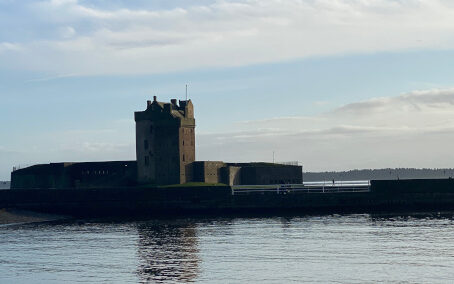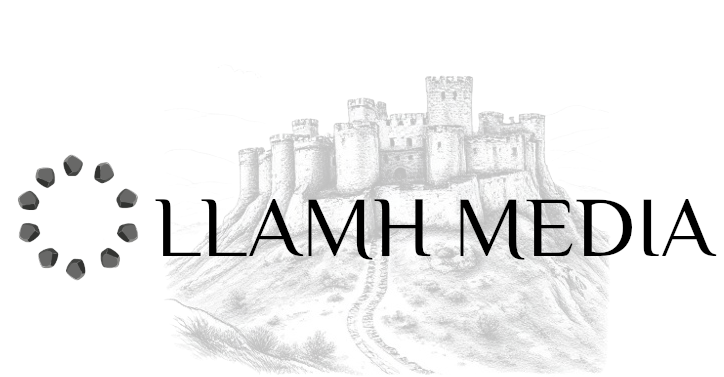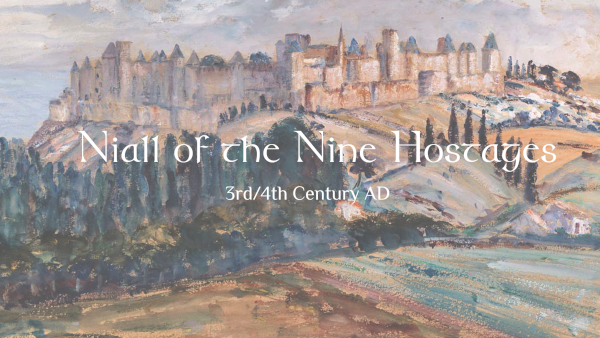The legendary Niall of the Nine Hostages lived and ruled Ireland at sometime between the late 3rd century and early 4th century C.E. He was a great expansive King and the ancestor of many people in areas where Gaelic people settled.
The Early Life of Niall of the Nine Hostages
There are various legendary accounts of Niall’s birth. The tale “The adventure of the sons of Eochaid Mugmedon”, is the most famous. Eochaid Mugmedon, a High King of Ireland had five sons, four of which with his Gaelic wife Mongfind. However, Niall’s mother was a princess named Cairenn Chasdub. Historians debate whether she was a Saxon princess or a Romano-British princess. Though they both agree he was born not of the same mother as his brothers. Eochaid’s second wife Cairenn was envied by Mongfind. While she was pregnant, Mongfind forced her to work. She had her complete laborious tasks, in the hope that she would miscarry. One day Cairenn went into labour while drawing out water for the family. Out of fear she leaves the baby Niall on the ground, exposed to birds. A poet named Torna then finds baby Niall and raises him. When he comes of age he returns to Tara and recuses his mother from her labour.
Niall of the Nine Hostage’s Accession to the Throne
Now that Niall had returned, he was much loved by the people. Aware of this, Mongfind, still a victim of her own jealousy demands that Eochaid names a successor to the throne. As was customary, Eochaid asks a Druid to decide the matter. Sithchenn the druid devises a competition. He places them into a burning forge, exclaiming “Save what you can”.
Niall emerges carrying an anvil, while the other brothers emerge with weapons, wood, and alcohol. Due to evidence of Niall’s long-sighted personality, the druid deemed him to be victorious. A personality befitting of a King. Mongfind was not satisfied and suggested that the boys should be tested once more. Sithchenn then took the brothers to a smith, who makes them weapons and then they are sent out hunting. Each brother in turn begins the hunt by looking for a water source. Each brother individually comes upon a hideous hag who promises them water in return for a kiss. Only Niall has the courage to kiss her properly. A beautiful lady appeared at once. In recognition of his sacrifice, she grants him not only water but kingship of Ireland for many generations. Twenty-six of Niall’s descendants would be High Kings of Ireland.
Warring Kingdoms
Now that Niall had claimed the throne of Ireland as a whole, he begins to establish his brothers as local kings. Brion rules the province of Connacht, but Fiachrae declares war on him. Brion defeats Fiachrae and hands him over as prisoner to Niall, while Fiachrae’s son Nath I continues the war and eventually kills Brion. Niall releases Fiachrae who reclaims Connacht and becomes Niall’s right-hand man. The warring then continues, as Fiachrae and Niall’s other brother Ailill declare war on the king of Munster, Eochaid. This war continues for many years.

The Death of Niall of the Nine Hostages
In the “Book of Invasions of Ireland”, it is written that there was a great war between Niall and the King of Leinster, over a tax that was to be paid to the High King. The King of Leinster’s son, Enna is named as Niall’s killer in almost all sources, however it is agreed that he died outside of Ireland. This may be due to the historical understanding that Niall conducted many raids throughout the British Isles and even into continental Europe. It is suggested that he died in Brittany in the northern reaches of what we know today as France. To think of him travelling this far can be a surprise to some and it is even said that he raided as far as the Alps, where the Romans sent an ambassador to meet with him.
Legacy
Niall is famous for carrying out the famous raid that brought Saint Patrick to Ireland as a slave. This event would change the cultural landscape of Ireland for many years to come, as Irish people the world over celebrate Saint Patricks Day every year on the 17th of March. Geneticists observed an interesting trend when conducting genetic research on the island of Ireland. Geneticists found Niall’s genetic marker concentrated in the north-west of Ulster and spread through the Island. Some geneticists have postulated that this marker confirms direct ancestry to the High King. There have even been reports of the marker in areas in Northern Europe, suggesting that the historical accounts of Gaelic raiders led by King Niall may very well be valid.

